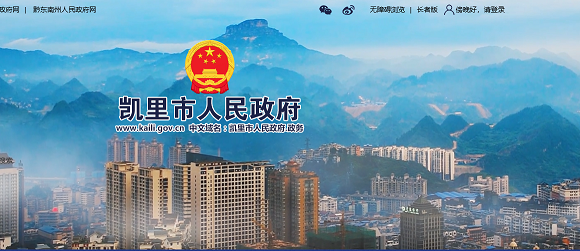- Profile Jurisdictions GOV DEPARTMENTS Cultures Travelling Educate
-
Kaili City is located in the eastern part of Guizhou Province, bordering Taijiang County to the east, Majiang County and Fuyuan City to the west, Leishan and Danzhai Counties to the south, and Huangping County to the north. The urban area of Kaili is approximately 160 kilometers from the provincial capital, Guiyang, with a total area of 1,569.7 square kilometers.

Geology and Topography Kaili City has a relatively complete geological stratigraphy, with a continuous sequence of marine strata and a rich fossil record. It is situated at the transition zone between the north-south structural deformation zone of the Guiding area of the Yangtze Platform and the South China Fold Belt. The topography is characterized by erosional structural types and karst structural types, with typical karst topography and erosional topography. Mountains, hills, medium-height mountains, and low-medium mountains cover 41.76% of the city's total area, low mountains account for 18.72%, low hills to medium-height hills account for 37.82%, and river valleys, basins, and river landforms account for 1.76% to 3%. The terrain is higher in the southwest and lower in the northeast, forming a slope zone transitioning from the western and southern Ma Zong Ling, Chang Ling Gang, Gou Mo Ye, and Mo Dong Po to the Hunan Hills, while also forming a low mountain and hill valley zone sloping from west to east. The highest point is Gou Mo Ye Peak (1,447 meters) in the south, and the lowest point is the Qing Shui Jiang River exit (529 meters). The watershed between the Chong'an River and the Qingjiang River runs from the Maozong Ridge to Dapo, Longwangpo, Daposhan (1,246 meters), Laoya Mountain, Paomuling, Xianglushan, Gouchang Ercun'an, and Luobangpo.

Land and Soil The total land area of the city is 1,569.7 square kilometers. The land is classified into eight grades. Except for Grade 8, which includes difficult-to-use land, residential areas, urban construction land, bare rock mountains, roads, and rivers, Grades 1 to 7 can be used for agricultural, forestry, and pastoral purposes, accounting for 94.35% of the total area. The soil consists of four soil types: yellow soil, limestone soil, purple soil, and paddy soil, with 15 sub-types, 36 soil groups, and 77 soil varieties.
Kaili City administers nine subdistricts: Daxiangzi Subdistrict, Ximen Subdistrict, Ximahu Subdistrict, Chengxi Subdistrict, Wanxi Subdistrict, Kaihuai Subdistrict, Baiguojing Subdistrict, Baiwu Subdistrict, and Yatang Subdistrict; and eleven towns: Lushan Town, Sankeshu Town, Wanshui Town, Longchang Town, Panghai Town, Wanchao Town, Zhouxi Town, Kaitang Town, Dafengdong Town, Bibo Town, and Xiasu Town. There are 166 village committees and 42 residents' committees.

During the Spring and Autumn Period, Kaili City belonged to the Nanman Zangke Kingdom. During the Warring States Period, it belonged to the Yelang Qulan Kingdom. During the Qin and Han Dynasties, it belonged to Qulan County. During the Sui Dynasty, it belonged to Binhua County. During the Tang Dynasty, it belonged to Binhua and Xinxing Counties. During the Song Dynasty, it was a tributary state under the jurisdiction of Shaqing Prefecture. During the Yuan Dynasty, it was under the jurisdiction of Majia County and Bozhou.
In the fourth year of the Hongwu reign of the Ming Dynasty (1371), the Zhen Dong Chieftain's Office was established. In the fifth year (1372), the Kaili Chieftain's Office was established. In the fourteenth year (1381), Qingping Fort was established. In the twenty-second year (1389), Qingping Fort was upgraded to a Chieftain's Office. On May 21, 1494 (June 23, 1494), the Qingping Chieftain's Office was renamed Qingping County, under the jurisdiction of Duyun Prefecture, which was in turn under the jurisdiction of the Guizhou Provincial Administration. On July 2, 1668 (August 9, 1668), Qingping County was abolished and merged into Mahazhou. On the first day of the twelfth month of the tenth year of the Yongzheng era (December 31, 1671), Qingping County was reestablished and remained under the jurisdiction of Duyun Prefecture. On the 29th day of the second month of the twelfth year of the Yongzheng era (March 23, 1734), an additional magistrate was appointed to Qingping County, stationed in Kaili, and referred to as the Kaili Magistrate. During the Kangxi era of the Qing Dynasty, Guizhou Province established the Guixi and Guidong circuits. Qingping County belonged to Duyun Prefecture and was under the jurisdiction of the Guidong Circuit. In the third year of the Xuantong era (1911), the Qing Dynasty's circuits were abolished, and Qingping County was under the jurisdiction of Duyun Prefecture. In September 1913, due to a name conflict with Qingping County in Shandong Province, Qingping County was renamed Lushan County, named after the Xianglu Mountain within its borders. On September 26, 1952, Lushan Miao Autonomous Prefecture (county-level) was established. On January 7, 1955, it was renamed Lushan Miao Autonomous County. In December 1956, Lushan Miao Autonomous County was restored to Lushan County. According to the State Council's Decision No. 92 on Administrative Division Changes issued on December 29, 1958, Lushan, Leishan, Danzhai, and Majiang counties were abolished, and their administrative areas were merged to form Kaili County, with the county seat established in Kaili. In January 1959, Kaili County was established in Majiang, and it officially relocated to Kaili in February of the following year. On August 18, 1961, Majiang County and Leishan County were restored (Danzhai County was reestablished on October 20, 1962). The former Lushan County retained the name Kaili County, with its county seat remaining in Kaili. On August 19, 1983, the State Council approved Document No. 162 of 1983, deciding to abolish Kaili County and establish Kaili City using its original administrative area. In January 1984, Kaili City was officially established. As of 2021, it administers 11 towns—Sankeshù, Kaitang, Zhouxi, Xiasī, Bìbō, Wàncháo, Longchǎng, Lúshān, Dàfēngdòng, Pánghǎi, and Wānshuǐ—and 9 subdistricts—Xǐmǎhé, Kāihuái, Dàshízǐ, Yátáng, Chéngxī, Xīmén, Wānxī, Báiguǒjǐng, and Báiwǔ.
contact details
Tel:00-86-0855-8065700
Address:3rd Floor, Building C, Administrative Center, Kaili City
Working hours:Monday to Friday (8:30 AM - 12:00 PM; 2:00 PM - 5:30 PM)
